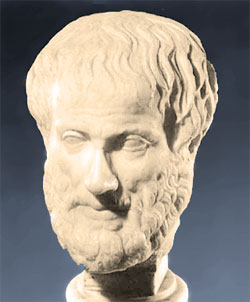Reading the Five Ways
11. ‘This is what everybody understands by God’?
Where do these Five Ways get Aquinas? Assuming that the world is ultimately intelligible, in the senses described, there must be some way in which the chains of ‘Why?’ questions stop, some answer that they reach which is an answer of a different kind. We can give this ‘answer of a different kind’ various abstract names: the unmoved mover, the uncaused cause, the necessary being on which all contingent being rests, and so on – and to do so is to do no more than to spell out what an ‘answer of a different kind’ means. We are, Aquinas has argued, looking for an answer that is not itself question begging – and all we know at this point is that there must be some such answer, not what it is, or (in Aquinas’ words) what manner of being it is.
Admittedly, it looks on a casual reading like Aquinas claims rather more than this. The first Way finishes, ‘Hence one is bound to arrive at some first cause of change not itself being changed by anything, and this is what everybody understands by “God”.’ The second way finishes, ‘One is therefore forced to suppose some first cause, to which everyone gives the name “God”.’ The third way simply finishes, ‘One is therefore forced to suppose something which must be, and owes this to no other thing than itself; indeed, it itself is the cause that other things must be.’ The fourth Way, however, finishes, ‘There is something therefore which causes in all other things their being, their goodness, and whatever other perfection they have. And this we call “God”.’ And the fifth: ‘Everything in nature, therefore, is directed to its goal by something with understanding, and this we call “God”.’
There are two slightly different ways of understanding what is going on here. One might (and I think with somewhat lesser plausibility) think that Aquinas is here directly addressing the person who believes in God but not in God’s demonstrability. ‘Look,’ he would be saying, ‘I’ve shown that “demonstrability” reaches as far as the existence of a first principle, an unmoved mover, a something on which all else depends… are you really going to tell me that this something is different from the God you already believe in? No, of course you are not: that would be an absurd refusal to use “God” in the way that all believing people do – as the creator of the world, who depends on nothing for his own existence. So, see, your God is demonstrable.’
A more plausible interpretation, I think, is that Aquinas is simply saying, ‘Let’s use the word “God” as a placeholder to name the “something” that these Ways point to, on the basis that “God” has always been the term used for the unmoved mover, the first cause, etc.’ In other words, by using the word ‘God’ here, he is making no further assumptions about what kind of reality this “God” is. The introduction of the name ‘God’ at this point is not an argument; it adds nothing (except some handy terminology) to the conclusions reached by the Five Ways.
Now, in the next section of the Summa, still without going beyond what is strictly contained in the endpoint reached by the Ways, Aquinas will go to go on to ask what it means for something to be an unmoved mover, first cause, and so on. And then, still later, he will go further, and ask whether and in what senses this reality can have applied to it the descriptions that Christians apply to God. In other words, although he thinks he has demonstrated that ‘God’ exists, he does not at this point think he has demonstrated what this God is, or whether it is the same reality as the ‘God’ named in Christian faith.
Of course, were the Five Ways directly addressed to atheist or sceptical readers, this strategy would need to be spelt out rather more clearly. Aquinas would need, perhaps, to do more to justify using the word ‘God’ as a placeholder, perhaps introducing it rather later; and he would need to do more to point out the way in which he is building an argument for the connection between this ‘God’ of the Five Ways and the God of Christian faith (rather than making that connection with a question-begging assertion). The Five Ways are, however, written primarily with an eye to those who already believe in God, but who need to be convinced of God’s demonstrability (and so of the possibility of a certain kind of rational discourse about God) – and so Aquinas’ does not bother to pick his terminology, or to signpost his route, in the best way to assuage sceptical doubts.
If, then, we are to translate Aquinas’ argument into a form suitable for an atheist audience, we might delete his claim that ‘everybody’ will happily use ‘God’ to name the end-point to which the Five Ways point. We might, instead, simply say: ‘Let X be whatever it is that answers these questions without begging further questions. X is the unmoved mover, the uncaused cause, the self-existent cause of existence and so on. Now, what manner of reality must this X be?’
(Note, by the way, that we have not shown that each of the Ways leads to the same reality, or that any one of them leads to a single, unique reality. So ‘X’ might name a whole set of realities – and that is one of the possibilities we will have to consider when asking what manner of reality X is.)
All this means, to repeat the point once more, that the Five Ways are radically incomplete on their own. Only if you carry on into the much longer and much more detailed arguments in Questions 3 to 11 of the Summa – the doctrine of divine Simplicity, and what follows from it – do you find Aquinas discussing the kind of reality that his proofs have demonstrated. And so only if you carry on into that material can you judge whether Aquinas is right to call it ‘God’.
It is probably worth saying here that if the arguments in Questions 3 to 11 show anything, it is that any reality that answers the questions posed in the Five Ways (without itself begging further questions) is going to be a very, very strange reality indeed – and one that is extremely difficult to talk about directly. Whatever ‘X’ is, it is not a reality that fits easily into any of our categorisations, or onto any of our lists: it is not in any sense going to be just one more ‘thing’ (albeit a rather special thing) in the list of things that there are. But that’s another story.

 You are standing in a field and are startled when, one by one, ten arrows shoot past you. Seven of them hit a nearby target; two undershoot; only one misses wildly, parting your hair and burying itself in a nearby tree. Whilst you can explain the movement of the arrow through the air by reference to the laws of simple projectile motion, you guess that something other than, say, a random explosion has hurled these arrows into the air: there is nothing that could ‘draw’ them towards the target so consistently unless they had somehow been aimed. There must be some being with a capacity to take the target into account – a capacity to aim – somewhere in the process.
You are standing in a field and are startled when, one by one, ten arrows shoot past you. Seven of them hit a nearby target; two undershoot; only one misses wildly, parting your hair and burying itself in a nearby tree. Whilst you can explain the movement of the arrow through the air by reference to the laws of simple projectile motion, you guess that something other than, say, a random explosion has hurled these arrows into the air: there is nothing that could ‘draw’ them towards the target so consistently unless they had somehow been aimed. There must be some being with a capacity to take the target into account – a capacity to aim – somewhere in the process. We are not those readers, and this claim sounds very strange in our ears. You can get a sense for it, though, by thinking about heat. You can, perhaps, imagine a worldview in which all heat in the world was believed ultimately to be derived from the sun, either as a direct result of the sun’s heat warming something up, or because the sun’s heat had somehow been stored in things to be released when they were burnt (or by some other process). If you saw things in this way, you might well regard claims about things on earth being more or less hot as involving the placement of those things somewhere on a scale that ran all the way up to the sun: ‘heat’ would, for you, mean ‘likeness to the sun’.
We are not those readers, and this claim sounds very strange in our ears. You can get a sense for it, though, by thinking about heat. You can, perhaps, imagine a worldview in which all heat in the world was believed ultimately to be derived from the sun, either as a direct result of the sun’s heat warming something up, or because the sun’s heat had somehow been stored in things to be released when they were burnt (or by some other process). If you saw things in this way, you might well regard claims about things on earth being more or less hot as involving the placement of those things somewhere on a scale that ran all the way up to the sun: ‘heat’ would, for you, mean ‘likeness to the sun’. In the 1980 film
In the 1980 film  If you want to get a clear mental picture of what the first Way says about the world, it is worth noting that the chains that Aquinas joins together are not necessarily in themselves temporal (even though each link in the chains is itself a temporal change). Aquinas is not presenting a picture of each new change depending upon some other change that took place some time before. Rather, he pictures the world as something more like a clock: the hands move because the spindle they are attached to moves; that spindle moves because this cog moves; this cog moves because that one does; that one does because the escapement mechanism moves; the mechanism moves because the pendulum moves: the clock as a whole is an ordered set of interlocking movements and dependencies.
If you want to get a clear mental picture of what the first Way says about the world, it is worth noting that the chains that Aquinas joins together are not necessarily in themselves temporal (even though each link in the chains is itself a temporal change). Aquinas is not presenting a picture of each new change depending upon some other change that took place some time before. Rather, he pictures the world as something more like a clock: the hands move because the spindle they are attached to moves; that spindle moves because this cog moves; this cog moves because that one does; that one does because the escapement mechanism moves; the mechanism moves because the pendulum moves: the clock as a whole is an ordered set of interlocking movements and dependencies.  Aquinas is able to see his world as an intelligible one because he looks through a lens polished by certain concepts. Those concepts help him articulate the world’s intelligibility.
Aquinas is able to see his world as an intelligible one because he looks through a lens polished by certain concepts. Those concepts help him articulate the world’s intelligibility. Imagine that you were walking across a foggy field, and suddenly found an iron chain dangling in front of you. The fog prevents you from seeing very high, but it is clear that the bottom link of the chain is dangling a foot or more above the ground. You can see that the bottom link is suspended from the second, the second from the third, and so on up to about the fiftieth – which is as far as you can see. You know, however, that the fiftieth link up must itself be suspended from something – and the chain seems securely suspended when you tug sharply downwards on it. Curious (and foolhardy), you climb a little way up the chain, and find that the fiftieth link is indeed suspended from the fifty-first, the fifty-first from the fifty-second, and so on and so on, as far up as you feel capable of climbing. You let yourself carefully back down to the ground.
Imagine that you were walking across a foggy field, and suddenly found an iron chain dangling in front of you. The fog prevents you from seeing very high, but it is clear that the bottom link of the chain is dangling a foot or more above the ground. You can see that the bottom link is suspended from the second, the second from the third, and so on up to about the fiftieth – which is as far as you can see. You know, however, that the fiftieth link up must itself be suspended from something – and the chain seems securely suspended when you tug sharply downwards on it. Curious (and foolhardy), you climb a little way up the chain, and find that the fiftieth link is indeed suspended from the fifty-first, the fifty-first from the fifty-second, and so on and so on, as far up as you feel capable of climbing. You let yourself carefully back down to the ground.
Recent Comments